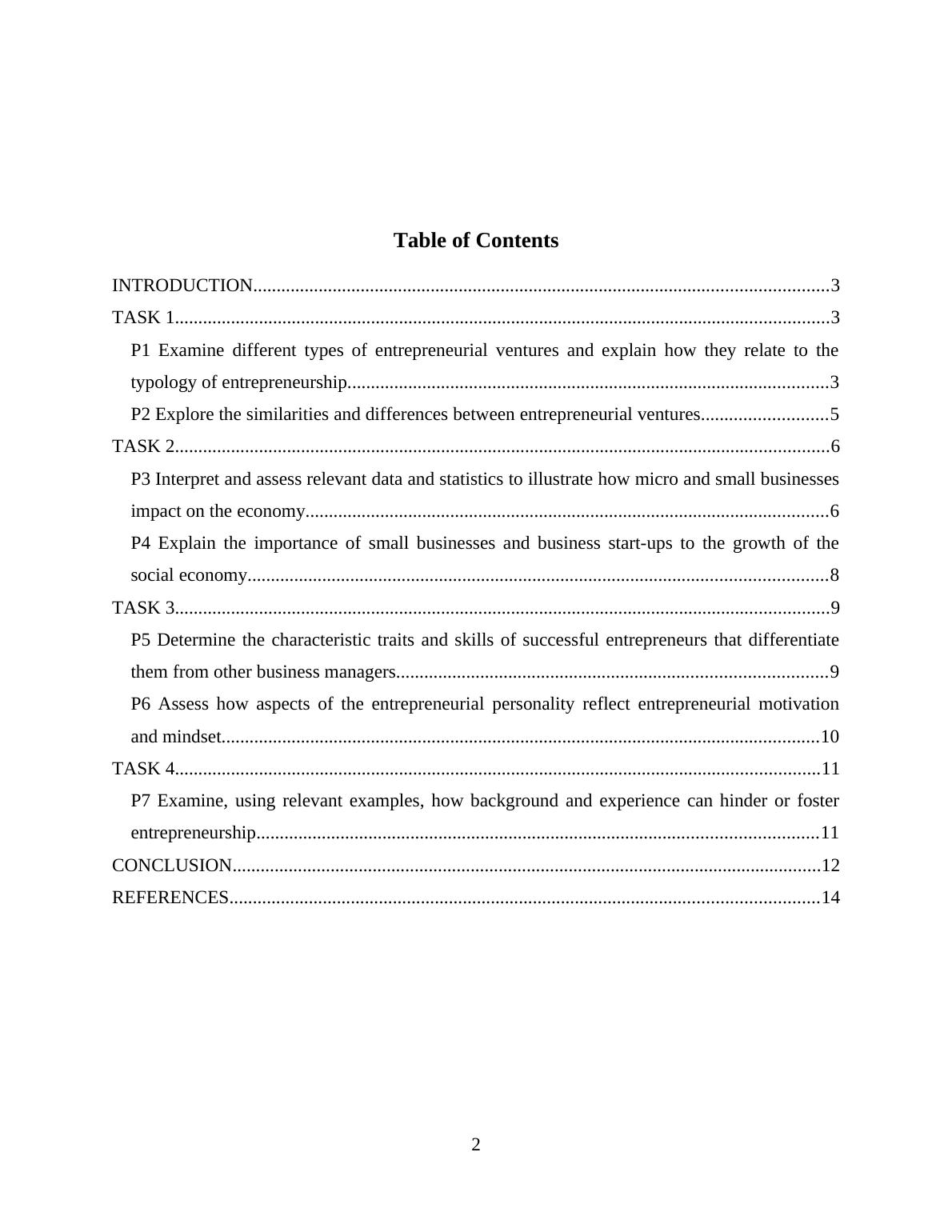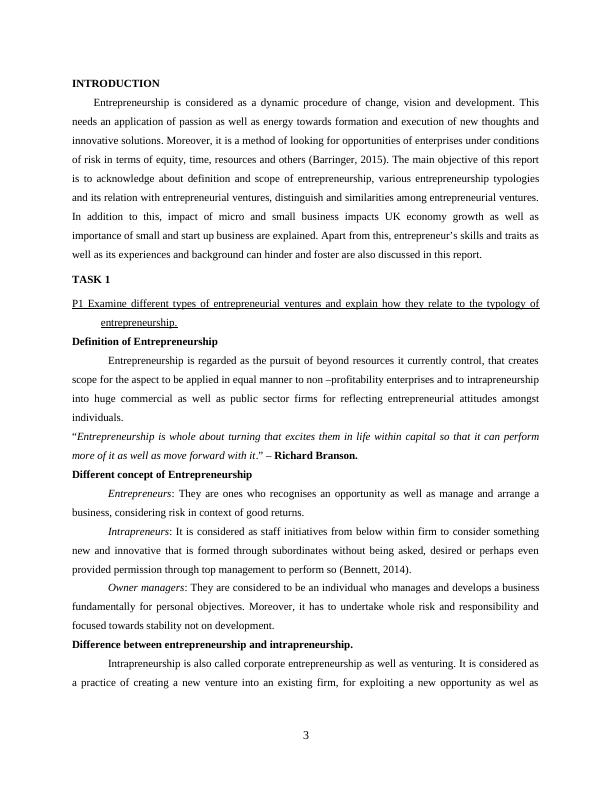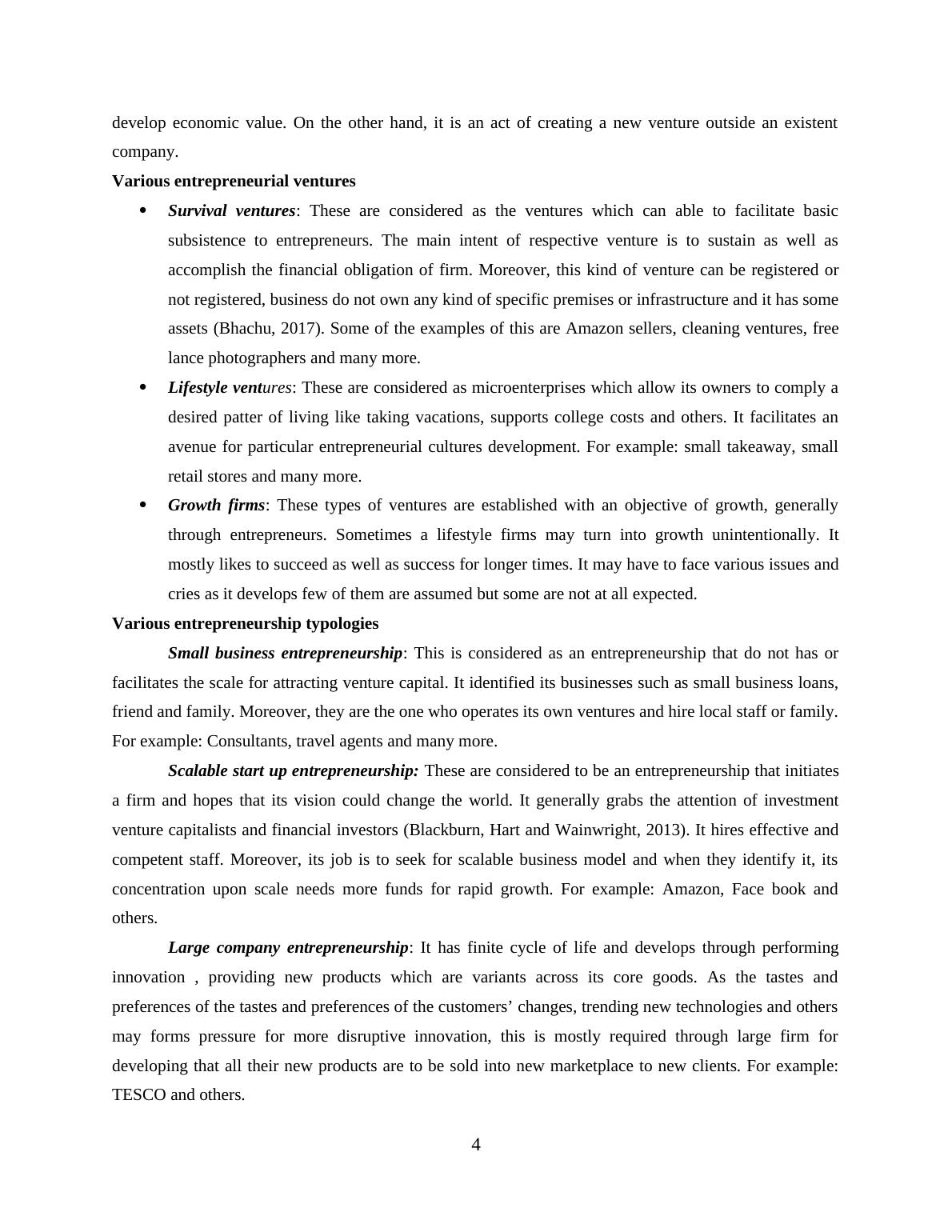Entrepreneurship and Small Business Management
15 Pages5472 Words94 Views
Added on 2023-01-10
About This Document
This document discusses different types of entrepreneurial ventures, their relation to the typology of entrepreneurship, and the impact of micro and small businesses on the economy. It also explores the importance of small businesses and startups to the growth of the social economy.
Entrepreneurship and Small Business Management
Added on 2023-01-10
ShareRelated Documents
ENTREPRENERUSHIP AND
SMALL BUSINESS
MANAGEMENT
1
SMALL BUSINESS
MANAGEMENT
1

Table of Contents
INTRODUCTION...........................................................................................................................3
TASK 1............................................................................................................................................3
P1 Examine different types of entrepreneurial ventures and explain how they relate to the
typology of entrepreneurship.......................................................................................................3
P2 Explore the similarities and differences between entrepreneurial ventures...........................5
TASK 2............................................................................................................................................6
P3 Interpret and assess relevant data and statistics to illustrate how micro and small businesses
impact on the economy................................................................................................................6
P4 Explain the importance of small businesses and business start-ups to the growth of the
social economy............................................................................................................................8
TASK 3............................................................................................................................................9
P5 Determine the characteristic traits and skills of successful entrepreneurs that differentiate
them from other business managers............................................................................................9
P6 Assess how aspects of the entrepreneurial personality reflect entrepreneurial motivation
and mindset................................................................................................................................10
TASK 4..........................................................................................................................................11
P7 Examine, using relevant examples, how background and experience can hinder or foster
entrepreneurship........................................................................................................................11
CONCLUSION..............................................................................................................................12
REFERENCES..............................................................................................................................14
2
INTRODUCTION...........................................................................................................................3
TASK 1............................................................................................................................................3
P1 Examine different types of entrepreneurial ventures and explain how they relate to the
typology of entrepreneurship.......................................................................................................3
P2 Explore the similarities and differences between entrepreneurial ventures...........................5
TASK 2............................................................................................................................................6
P3 Interpret and assess relevant data and statistics to illustrate how micro and small businesses
impact on the economy................................................................................................................6
P4 Explain the importance of small businesses and business start-ups to the growth of the
social economy............................................................................................................................8
TASK 3............................................................................................................................................9
P5 Determine the characteristic traits and skills of successful entrepreneurs that differentiate
them from other business managers............................................................................................9
P6 Assess how aspects of the entrepreneurial personality reflect entrepreneurial motivation
and mindset................................................................................................................................10
TASK 4..........................................................................................................................................11
P7 Examine, using relevant examples, how background and experience can hinder or foster
entrepreneurship........................................................................................................................11
CONCLUSION..............................................................................................................................12
REFERENCES..............................................................................................................................14
2

INTRODUCTION
Entrepreneurship is considered as a dynamic procedure of change, vision and development. This
needs an application of passion as well as energy towards formation and execution of new thoughts and
innovative solutions. Moreover, it is a method of looking for opportunities of enterprises under conditions
of risk in terms of equity, time, resources and others (Barringer, 2015). The main objective of this report
is to acknowledge about definition and scope of entrepreneurship, various entrepreneurship typologies
and its relation with entrepreneurial ventures, distinguish and similarities among entrepreneurial ventures.
In addition to this, impact of micro and small business impacts UK economy growth as well as
importance of small and start up business are explained. Apart from this, entrepreneur’s skills and traits as
well as its experiences and background can hinder and foster are also discussed in this report.
TASK 1
P1 Examine different types of entrepreneurial ventures and explain how they relate to the typology of
entrepreneurship.
Definition of Entrepreneurship
Entrepreneurship is regarded as the pursuit of beyond resources it currently control, that creates
scope for the aspect to be applied in equal manner to non –profitability enterprises and to intrapreneurship
into huge commercial as well as public sector firms for reflecting entrepreneurial attitudes amongst
individuals.
“Entrepreneurship is whole about turning that excites them in life within capital so that it can perform
more of it as well as move forward with it.” – Richard Branson.
Different concept of Entrepreneurship
Entrepreneurs: They are ones who recognises an opportunity as well as manage and arrange a
business, considering risk in context of good returns.
Intrapreneurs: It is considered as staff initiatives from below within firm to consider something
new and innovative that is formed through subordinates without being asked, desired or perhaps even
provided permission through top management to perform so (Bennett, 2014).
Owner managers: They are considered to be an individual who manages and develops a business
fundamentally for personal objectives. Moreover, it has to undertake whole risk and responsibility and
focused towards stability not on development.
Difference between entrepreneurship and intrapreneurship.
Intrapreneurship is also called corporate entrepreneurship as well as venturing. It is considered as
a practice of creating a new venture into an existing firm, for exploiting a new opportunity as wel as
3
Entrepreneurship is considered as a dynamic procedure of change, vision and development. This
needs an application of passion as well as energy towards formation and execution of new thoughts and
innovative solutions. Moreover, it is a method of looking for opportunities of enterprises under conditions
of risk in terms of equity, time, resources and others (Barringer, 2015). The main objective of this report
is to acknowledge about definition and scope of entrepreneurship, various entrepreneurship typologies
and its relation with entrepreneurial ventures, distinguish and similarities among entrepreneurial ventures.
In addition to this, impact of micro and small business impacts UK economy growth as well as
importance of small and start up business are explained. Apart from this, entrepreneur’s skills and traits as
well as its experiences and background can hinder and foster are also discussed in this report.
TASK 1
P1 Examine different types of entrepreneurial ventures and explain how they relate to the typology of
entrepreneurship.
Definition of Entrepreneurship
Entrepreneurship is regarded as the pursuit of beyond resources it currently control, that creates
scope for the aspect to be applied in equal manner to non –profitability enterprises and to intrapreneurship
into huge commercial as well as public sector firms for reflecting entrepreneurial attitudes amongst
individuals.
“Entrepreneurship is whole about turning that excites them in life within capital so that it can perform
more of it as well as move forward with it.” – Richard Branson.
Different concept of Entrepreneurship
Entrepreneurs: They are ones who recognises an opportunity as well as manage and arrange a
business, considering risk in context of good returns.
Intrapreneurs: It is considered as staff initiatives from below within firm to consider something
new and innovative that is formed through subordinates without being asked, desired or perhaps even
provided permission through top management to perform so (Bennett, 2014).
Owner managers: They are considered to be an individual who manages and develops a business
fundamentally for personal objectives. Moreover, it has to undertake whole risk and responsibility and
focused towards stability not on development.
Difference between entrepreneurship and intrapreneurship.
Intrapreneurship is also called corporate entrepreneurship as well as venturing. It is considered as
a practice of creating a new venture into an existing firm, for exploiting a new opportunity as wel as
3

develop economic value. On the other hand, it is an act of creating a new venture outside an existent
company.
Various entrepreneurial ventures
Survival ventures: These are considered as the ventures which can able to facilitate basic
subsistence to entrepreneurs. The main intent of respective venture is to sustain as well as
accomplish the financial obligation of firm. Moreover, this kind of venture can be registered or
not registered, business do not own any kind of specific premises or infrastructure and it has some
assets (Bhachu, 2017). Some of the examples of this are Amazon sellers, cleaning ventures, free
lance photographers and many more.
Lifestyle ventures: These are considered as microenterprises which allow its owners to comply a
desired patter of living like taking vacations, supports college costs and others. It facilitates an
avenue for particular entrepreneurial cultures development. For example: small takeaway, small
retail stores and many more.
Growth firms: These types of ventures are established with an objective of growth, generally
through entrepreneurs. Sometimes a lifestyle firms may turn into growth unintentionally. It
mostly likes to succeed as well as success for longer times. It may have to face various issues and
cries as it develops few of them are assumed but some are not at all expected.
Various entrepreneurship typologies
Small business entrepreneurship: This is considered as an entrepreneurship that do not has or
facilitates the scale for attracting venture capital. It identified its businesses such as small business loans,
friend and family. Moreover, they are the one who operates its own ventures and hire local staff or family.
For example: Consultants, travel agents and many more.
Scalable start up entrepreneurship: These are considered to be an entrepreneurship that initiates
a firm and hopes that its vision could change the world. It generally grabs the attention of investment
venture capitalists and financial investors (Blackburn, Hart and Wainwright, 2013). It hires effective and
competent staff. Moreover, its job is to seek for scalable business model and when they identify it, its
concentration upon scale needs more funds for rapid growth. For example: Amazon, Face book and
others.
Large company entrepreneurship: It has finite cycle of life and develops through performing
innovation , providing new products which are variants across its core goods. As the tastes and
preferences of the tastes and preferences of the customers’ changes, trending new technologies and others
may forms pressure for more disruptive innovation, this is mostly required through large firm for
developing that all their new products are to be sold into new marketplace to new clients. For example:
TESCO and others.
4
company.
Various entrepreneurial ventures
Survival ventures: These are considered as the ventures which can able to facilitate basic
subsistence to entrepreneurs. The main intent of respective venture is to sustain as well as
accomplish the financial obligation of firm. Moreover, this kind of venture can be registered or
not registered, business do not own any kind of specific premises or infrastructure and it has some
assets (Bhachu, 2017). Some of the examples of this are Amazon sellers, cleaning ventures, free
lance photographers and many more.
Lifestyle ventures: These are considered as microenterprises which allow its owners to comply a
desired patter of living like taking vacations, supports college costs and others. It facilitates an
avenue for particular entrepreneurial cultures development. For example: small takeaway, small
retail stores and many more.
Growth firms: These types of ventures are established with an objective of growth, generally
through entrepreneurs. Sometimes a lifestyle firms may turn into growth unintentionally. It
mostly likes to succeed as well as success for longer times. It may have to face various issues and
cries as it develops few of them are assumed but some are not at all expected.
Various entrepreneurship typologies
Small business entrepreneurship: This is considered as an entrepreneurship that do not has or
facilitates the scale for attracting venture capital. It identified its businesses such as small business loans,
friend and family. Moreover, they are the one who operates its own ventures and hire local staff or family.
For example: Consultants, travel agents and many more.
Scalable start up entrepreneurship: These are considered to be an entrepreneurship that initiates
a firm and hopes that its vision could change the world. It generally grabs the attention of investment
venture capitalists and financial investors (Blackburn, Hart and Wainwright, 2013). It hires effective and
competent staff. Moreover, its job is to seek for scalable business model and when they identify it, its
concentration upon scale needs more funds for rapid growth. For example: Amazon, Face book and
others.
Large company entrepreneurship: It has finite cycle of life and develops through performing
innovation , providing new products which are variants across its core goods. As the tastes and
preferences of the tastes and preferences of the customers’ changes, trending new technologies and others
may forms pressure for more disruptive innovation, this is mostly required through large firm for
developing that all their new products are to be sold into new marketplace to new clients. For example:
TESCO and others.
4

End of preview
Want to access all the pages? Upload your documents or become a member.
Related Documents
Entrepreneurship and Small Business Managementlg...
|12
|2751
|25
Small Business and Entrepreneurshiplg...
|18
|5243
|271
Entrepreneurs and Small Businesslg...
|14
|3903
|27
Entrepreneurship and Small Business Managementlg...
|13
|4626
|92
Assignment on Entrepreneurship and Small Business organizationlg...
|17
|4433
|18
Entrepreneurship and Small Business Managementlg...
|10
|3267
|149
